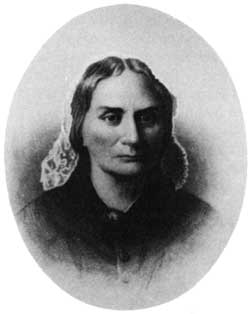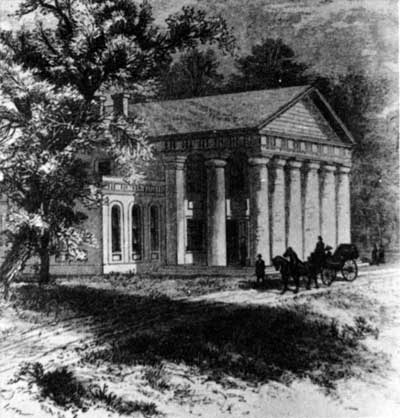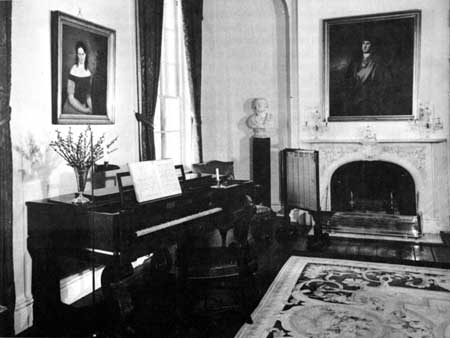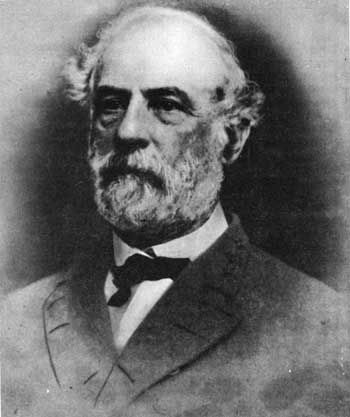|
CUSTIS-LEE MANSION The Robert E. Lee Memorial |
 |
History of Arlington to 1861 (continued)
DEATH OF MR. CUSTIS. Life at Arlington and for the father far away in Texas flowed on quietly during 1857. Although badly crippled by rheumatism, Mrs. Lee was able to manage the household and spend much time in her garden, while her father occupied himself as usual. But in the fall a telegram came to Lee, telling him of Mr. Custis' death on October 10th. Letters from the family told him more of the sad event: how Mr. Custis had been ill of pneumonia only 4 days, how he had steadily failed, and how on the last day, after embracing his weeping daughter and grandchildren and asking to be remembered to his son-in law, had passed away while his rector said the prayers for the dying. His last wish had been to be buried by the side of his wife, and to that spot his coffin had been borne by the family servants, followed by the Lees and a host of relatives and friends.
 Mrs. Robert E. Lee. This engraving was probably made from a photograph taken sometime after 1865. |
LEE BECOMES MASTER OF ARLINGTON. It was a saddened household to which Lee returned as soon as he could, made more so because Mrs. Lee's illness had progressed to where she was almost incapable of getting about the house. He found it necessary to take an extended leave in order to take on the management of Mr. Custis' properties and, as his executor, to carry out the terms of his will. This provided that after outstanding debts had been paid and legacies given each of the Lee girls, the farms were to go to the boys, although Mrs. Lee would have possession of Arlington until her death, after which it would pass to Custis Lee. All the slaves were to be freed within 5 years.
A large debt had to be paid off before anything else could be done, and Lee applied himself to making the farms as productive as possible by putting more land under cultivation and planting larger crops. For a time, it seemed that it would be impossible for him ever to discharge his obligations satisfactorily, but he could still hide his discouragement from his children, as when in the autumn of 1858 he came upon one of his daughters saying a tearful goodbye to a friend, and said cheerfully to the weeping girls: "No tears at Arlington, no tears." Fortunately, by the summer of 1859 he could see some improvement in the situation, although much remained to be done.
JOHN BROWN'S RAID AND THE IMPENDING CRISIS. One morning in October 1859, a young lieutenant, J. E. B. Stuart, who had been a guest at Arlington several times, came with orders for Lee to report at once to the Secretary of War. There he learned of John Brown's raid on Harpers Ferry and was directed to take command of the forces being sent to quell the uprising. This was soon accomplished, and in a short while Lee was home again.
Affairs at Arlington were so encouraging that autumn, that Lee expected soon to rejoin his regiment in Texas. Therefore, he arranged to have his son, Custis, who was now in the Corps of Engineers, transferred to Washington where he could supervise the estate. Unlike many army officers, Lee had never been away long from his native State, and his months of hard work at Arlington had given him a sympathetic understanding of the problems faced by his kinsmen and fellow-planters and reaffirmed his belief that his first loyalty was to Virginia.
These were his views when he went to Texas in February 1860, and they remained unchanged as the discord between the North and South grew more intense. Uneasily, he observed the recklessness of the extremists on both sides, hoping always that the Union he loved would be preserved. Texas seceded in February 1861, and Lee, who had been ordered to report to Washington, arrived home at Arlington a month later. "I met Col. Robert E. Lee at Gen. Scott's office," one of his army friends wrote in his diary, March 5th. "He feels badly at the prospect." Probably all that Lee could tell his old friend was that if Virginia seceded he must follow her, and that all he could do was to await developments.
 "Arlington House" as it appeared a few years before the Civil War. From a sketch by Benson J. Lossing |
LEE RESIGNS FROM THE UNITED STATES ARMY. While Lee watched, helpless, events moved rapidly. Fort Sumter was bombarded in April, and in a few days Lee heard that his own beloved Virginia had seceded. Great as was his pride in the Union, he did not believe that it should be preserved by force; moreover, he felt his first allegiance was to his State. Though his career be sacrificed and the lives and property of his children endangered, he believed he must do his duty as he saw it.
Arlington blazed with lights Friday night, April 19, 1861, and was filled with relations and friends anxiously discussing the recent events. Finding it impossible to think about his problem amid the excitement, Colonel Lee went outside and paced back and forth under the trees while he pondered his future course. Still undecided, he returned to the house and went up to his bedroom. Downstairs, Mrs. Lee and the others waited anxiously. Overhead, they could hear Lee's footsteps as he paced the floor, stopping only when he knelt to pray. It was after midnight when he finally arrived at a decision and sat down to write his resignation from the United States Army. That done, he came down with it in his hand to where his wife was waiting. "Well, Mary," he said quietly, "the question is settled. Here is my letter of resignation, and a letter I have written to General Scott."

A corner of the drawing room, 1956.

General Robert E. Lee in 1862.
U. S. Army
Signal Corps photograph.
THE LEES LEAVE ARLINGTON. Monday morning, Lee said goodbye to his family and left for Richmond. Before him were the long, hard years of a bitter war from which he would gain unfading glory. But never again would he be sheltered by the friendly roof of his old home at Arlington, and only once would he have a glimpse of it, and then from a passing train, several years after the war.
In view of the strategic location of Arlington, Lee urged his wife to go to a place of safety, but no preparations had been made to leave when word reached Mrs. Lee, early in May, that the Federal forces were soon to move into Virginia. Then all was excitement as the family portraits were taken from their frames and, with the plate and the most valuable Washington relics, sent off for safekeeping. Curtains and carpets were packed away in the attic, books and engravings put in closets, and the china stored in boxes in the cellar. Most of the furniture had to be left behind, but this Mrs. Lee trusted she could recover later. When every thing was in order, it was time to say farewell to the weeping servants, and to leave her home for what was to be the last time.

|
|
Last Modified: Mon, Dec 2 2002 10:00:00 am PDT |


